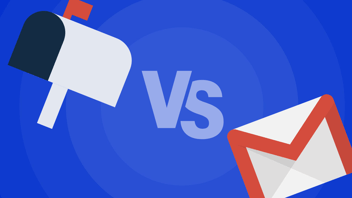Using Direct Mail to Reach Generation Z Customers | Taradel
It is difficult to imagine a world devoid of the Internet. Our current age is thoroughly saturated with digital technology, and the vast majority of individuals are connected in some form or fashion for a significant portion of the day. The internet has become almost like a new utility - essential to modern life and almost tethered to it in various ways.
From browsing the internet looking for goods and services to hopping on social media to catch up with the latest news - and everything in between - our lives our now fully entwined with digital platforms, whether we like it or not.
Although some of us may recall a time before the digital age (which was merely a few decades ago), a significant portion of the population has never experienced such a world. Generation Z, comprising individuals born after 1997, have been immersed in the digital realm since their earliest days and would likely find themselves slightly disoriented without it.
Surprising Affinity
With this reality in mind, you would be forgiven for assuming that the good people of Gen Z would recoil in horror at the prospect of receiving ‘old-fashioned’ print communication. You might expect that of all the age groups, Gen Z would probably be the least suitable candidates for direct mail advertisements.
Well, as it turns out, you would be wrong. It just so happens that Zoomers are not only fully receptive to direct mail marketing, you might even say they embrace this last bastion of print marketing and respond to it very well indeed.
By shedding light on a few key stats and addressing various misconceptions, we are going to explain why direct mail should be a serious consideration for anyone targeting the Gen-Z market. But first, let's cover a few general points about direct mail marketing.
Alive and Kicking
Direct mail campaigns are likely familiar to many of you, but for those who are unfamiliar, direct mail (also known as direct mailers) refers to printed advertising material that is addressed and sent to a potential consumer's or business's physical address.
Direct mail advertising offers a unique opportunity to establish relationships with potential customers by providing a tangible form of messaging that connects a business or brand with its target market. Unlike digital marketing strategies, direct mail offers a physical medium that can help to convey a message and create a lasting impression effectively.
In the most literal sense, direct mail campaigns deliver marketing messages directly into the hands of potential customers through well-designed and well-targeted direct mailers. This approach can help to establish a strong brand connection with customers, as they physically hold and interact with the marketing materials.
Is Direct Mail Effective?
While some people might think that direct mail campaigns are archaic and come from a different time in marketing, the reality is very different. In truth, a lot of effective marketers still use direct mail advertising and profit from the lower level of mailbox competition. They can use their direct mailers as a more potent and effective messaging tool by taking this strategy.
In contrast to the intense competition for attention in digital advertising, direct mail campaigns benefit from a lower level of mailbox competition. While the majority of marketers rely on digital platforms to promote and sell products, inundating potential customers with a barrage of digital ads, direct mail offers a more targeted and personalized approach that can help to cut through the noise and grab customers' attention.
Banner Blindness
As the internet and other digital media have become saturated with advertising - resulting in what is known as 'banner blindness.’ - the pendulum is beginning to swing in the opposite direction, as savvy marketers are allocating more resources to direct mail marketing.
The intense competition in the digital space has made it increasingly challenging for marketers to capture consumers' attention and convey their messages effectively.
As a result, traditional print marketing methods like direct mail campaigns have experienced a resurgence. With reduced competition, consumers are more receptive to direct mail, resulting in an upturn in results.
But is direct mail marketing relevant for Generation Z target recipients? Absolutely! There are several specific reasons why direct mail marketing could be a valuable tool for marketers targeting this specific age group. Let's explore some key points that highlight the benefits of this approach.
Direct Mail & Zoomers
There are various anecdotal reasons why direct mail is such an effective tool for the Generation Z demographic - and we will get to that shortly - but there are actually definitive and resounding research stats to back up the anecdotal evidence conducted by the highly respected marketing authority known as WARC (or the World Advertising Research Center), and The Royal Mail, a 500-year-old British institution who happens to know a thing or two about pushing out mailings!
The report, titled "Driving Effectiveness with Direct Mail," analyzed 218 direct mail campaigns published between 2018 and 2020 that utilized direct mail either as the lead media or in the marketing mix. The research revealed that 35% of the campaigns that used direct mail recorded a return on investment benefit.
Considering the US national average is just 23%, that is quite a remarkable difference and might come as a surprise to those unfamiliar with direct mail. It is also worth remembering that many marketers use direct mail for brand awareness or as part of a mixed digital strategy, both of which are very hard to quantify in terms of ROI or Return on Investment. Take those out of the equation, and the percentages would probably be closer to 70%.
The report attributes the physical nature of direct mail as the reason for this success, with an engagement rate averaging 95%. WARC researchers emphasized that campaigns using direct mail have driven a notable impact on effectiveness metrics like ROI and revenue.
Engagement
However, it was the digitally native Gen Z who, according to the report, expressed a preference towards direct mail over any other form of advertising, according to the report.
This is probably due to the fact that Zoomers, representing almost one-third of the population, have grown up with digital communication as the standard, and physical mail offers something unique.
Almost 90% of those surveyed said they preferred a mix of physical and digital marketing. Additionally, 42% searched for a brand online after receiving direct mail, and 84% scanned a QR code from mail to interact with a brand online.
In short, Generation Z is more receptive to direct mail over digital advertising owing to the fact it is unique, tangible, and personal. Zoomers spend more time online than any other generation and, as a result, are more inclined to suffer from ‘banner blindness.’ From their perspective, direct mail serves as a refreshing change in the digital world.
How to Capitalize?
So, direct mail is an effective tool to reach Zoomers. However, there is a caveat, and it is something you need to be aware of if you want to make the most of this demographic.
Generation Z is notorious for having low attention spans when it comes to advertising and messaging. Research suggests that Zoomers have the highest bounce rate when browsing marketing messages. On average, Zoomers will ‘bounce’ after 4 seconds of digesting marketing or promotional material.
But there are methods and strategies you can employ to circumnavigate that problem and ensure your direct marketing is effective with Gen Z. We have identified three crucial elements of successful direct mail marketing when targeting this particular demographic:
Personalization
Where possible, targeted marketing works far better with Zoomers than generic ‘blanket’ messaging, as tech-savvy Generation Z values uniqueness and authenticity over vague messaging.
You can give recipients a more engaging and memorable experience by personalizing the content, for as by addressing them by name, including unique offers or promotions, or adapting the messaging to their interests and preferences.
If you have access to targeted lists, we suggest you make use of it by constructing a mail merge campaign targeting zoomers with something personalized. If you don't have a list available or would like to increase reach, we are able to reach this highly lucrative demographic in any state, city, or town across America through our well-managed and extremely responsive personalized lists.
Multi Chanel Marketing
Generation Z is a highly online-connected group, with many of them using multiple digital devices throughout the day. To effectively target them with direct mail, it's important to integrate both digital and mail channels into your campaign. Actually, with Zoomers, it is almost a prerequisite.
You could use direct mail to drive traffic to your website or social media pages or incorporate QR codes or personalized URLs (PURLs) in your mail pieces to make it easy for them to engage with your brand online. Essentially, the goal here is to ‘warm up’ the recipients with direct mail, encourage brand engagement, and direct them to an online channel for your call to action.
Use Humor
Zoomers are far more likely to engage with direct mail if the messaging resonates through mild humor. By injecting a more playful tone of voice, you are far more likely to draw recipients toward your call to action. Be careful here, however. We are not suggesting you write a stand-up comedy script, but rather keep things light, playful, and energetic.
Wrap-Up
Direct mail can be a hugely productive strategy not just with Generation Z but across all demographics. This reliable and long-trusted marketing technique is enjoying a resurgence of late in an age of digital saturation.
However, it is Zoomers who are particularly responsive to direct mail - especially when combined with other marketing channels. Direct mail will stand out from the digital clutter and leave a lasting impact by interacting with Gen Z through customization, multichannel marketing, sustainability, and even novelty factor.


.png?width=352&name=Add%20a%20heading%20(8).png)